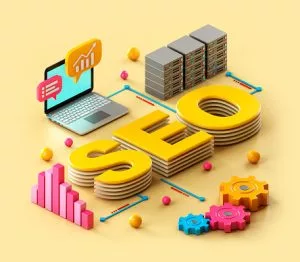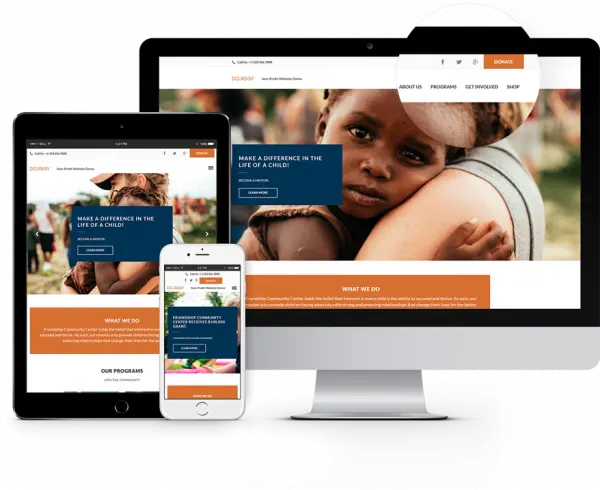
Search engine optimization (SEO) can sound intimidating to many nonprofit and development professionals. And do you really need to worry about SEO for nonprofits? With all the concerns of creating and maintaining a website, developing your nonprofit’s fundraising strategies, and focusing on your core mission, SEO can easily seem optional.
But understanding how Nonprofit SEO works can profoundly impact your organization’s website traffic, getting donations, and garnering volunteers and supporters. Just like any business or organization, SEO allows a nonprofit organization to be found online – and that’s important. After all, if you found us and are reading this blog, it’s probably because we optimized SEO well.
Luckily, we’re here to walk you through how SEO works for nonprofits and how to utilize SEO strategies to benefit your nonprofit website and bottom line.
What Is SEO for Nonprofits? Do Nonprofits Really Need to Worry About SEO?

Let’s start with the most important question: What is SEO for non-profits? SEO stands for search engine optimization, and it simply means using optimization tactics to appear higher in search engine results. Major search engines, like Google and Bing, serve as a vital source of information online. The higher the ranking of your website in a search engine, the more likely your website will be found. As you go further down the search results, it becomes more unlikely that someone will find your website content.
A nonprofit SEO strategy is essentially the same as an SEO strategy for businesses. Constituents need to be able to easily find your organization’s website to connect or make a donation. If not, they will likely find another organization and may decide to offer their support there. When was the last time you searched page 4 or 5 of Google when looking for a product or service?
Fact: If your nonprofit website doesn’t appear on the first page of a search, chances are that your organization will not be found.
What Factors Affect Search Engine Ranking?

Search engines use an algorithm (a complex set of formulas) to determine which websites rank for a given search. These algorithms are constantly changing and cannot be pinned down precisely. However, we know several factors that play into Google and other search engine algorithms. Some of these factors are easier to affect than others.
Let’s discuss the top focus areas to optimize your non-profit SEO strategy.
- Keyword Research
- Content Creation
- On-page Optimization
- Linking (both internally and externally)
- Social Sharing
Nonprofit SEO Strategy: 6 Steps to Get Your Organization Started Right
Now that we’ve determined nonprofits need to concentrate on SEO, let’s find out how to do just that. You’ll need to develop a nonprofit SEO strategy to succeed. Here are the building blocks of SEO for non-profits, schools, and any business or organization.

SEO for Nonprofits Strategy #1: Research Keywords Well
What work does your organization do? What do you want to write about? Having a general idea of your topic is obviously a good starting point, but it likely won’t be enough to lay the foundation of an optimized website or page. Researching the keywords to incorporate into your nonprofit website, article, blog, or even social media post is an essential step toward helping your SEO ranking. Don’t forget that if you serve a local area, adding your city or state into your keyword strategy can help you to be found.

Not all keywords are worth the same and the ideal keywords are the ones that are a balance between most frequently searched and not being overly saturated or competitive. There are free keyword research tools that exist that can help you find out which keyword options are best for your topic (based on how often they are searched).
SEO for Non-Profits Strategy #2: Develop Your Content Strategically
‘Content is King’ is a popular catchphrase in the world of search engine optimization. Writing valuable content that speaks to your audience is really what it’s all about. All of the other factors are there to show search engines what great content looks like – but it all comes down to the content.
Great content consists of engaging information for your audience combined with actionable items. Both are important to keep your constituents and website visitors reading through your post or clicking through your website. In addition to good information, part of the strategy that optimizes your website or article is immersing the ideal keywords throughout the content.

The frequency of your keywords on your website or page is called keyword density. There is no hard and fast rule on how often a keyword should appear, as it can vary based on how saturated your topic is on the internet. However, a best practice is to have the keyword appear in the page title, the meta (page) description, and at least a couple of times within the first paragraph or 100 words of copy. From there, your SEO keywords should naturally and frequently appear throughout your content.
SEO for Non-Profits Strategy #3: On-Page Optimization is Key to SEO Success

On-page optimization refers to website-related factors that help with the SEO ranking of your non-profit website or article. These factors show search engines that your content is well organized and act as a cheat sheet to categorize your content. On-page optimization includes the following:
- Title Tag: The title of your website, article, or post that appears in the search engine when your page appears in the results. The title of the page ideally contains the primary keywords and is catchy enough to entice a click.
- H1 and H2 Headings: These are the headings and subheadings throughout the article that should incorporate the primary keyword(s) and other related keywords.
- Page/Meta Description: The brief summary of the page that appears below the title tag in search engine results. The key in the metadata description is that it contains the primary keywords and actionable items. It should also be brief enough to fit within the search engine description. Google recently changed the length of the meta description to about 155-160 characters, so this is now the standard.
- Readability Score: The readability score indicates how easy your content is to read in relevance to school reading levels. While sounding highly knowledgeable and studious sometimes sounds like a good idea for credibility, being difficult to read does not help with your ranking and may hinder your non-profit website from being shareable on social media. Short, concise sentences are key here.
- Friendly Content and Layout: Even the best content must be presented in a way that can easily be digested. Some friendlier factors include using shorter sentences, frequent paragraph breaks, use of white space, and images to help make your content more appealing to read.

One of the most helpful tools available to assist with on-page optimization is Yoast. That’s why all of DoJiggy’s nonprofit websites built on the WordPress platform include the Yoast plug-in integrated into your publisher. This integration makes it simple to check that these on-page factors are being optimized.
SEO for Nonprofits Strategy #4: Focus on Internal Linking
Linking refers to the hyperlinks within a website or page. There are two types of linking to consider, and both are very important to nonprofit SEO: internal and external.

Internal linking is a link that leads to other pages within your website. It allows visitors to explore your website further and to increase traffic on your pages throughout your website. Here, you are strategically sending readers to more information that further answers their query. For example, a private school website may have a website page that discusses admissions requirements. On this page, the school can include internal links that refer readers to tuition and fees as well as the school curriculum. These are related content pieces that require their own website page.
Internal linking is great, as it allows you to point users to the content you wish to highlight. And here is the key – you have complete control over this kind of link. You send readers to your most important pages.
SEO for Non-Profits Strategy #5: Focus on External Linking
External linking is a link that comes to your website from another website. The more websites that link to your website, the more important and authoritative your content is regarded. So reach out to other local nonprofits and see if they can link to your website. Research directories and local SEO opportunities as well.
You may also wish to practice external linking to other websites. External linking to other sites can certainly work towards your advantage when approached strategically. It is important to link to credible websites only, as the credibility of these links affects the trustworthiness of your own website.

Link exchanges are a great way to build value in a partnership and collaboration with another organization. If someone has a high-ranking or reputable website, you can ask if they can link your website in exchange for doing the same with theirs. It can be especially beneficial when you are externally linking using a keyword that isn’t the primary keyword of your article. Typically, organizations with a website can view the sources of their website traffic to see how this exchange benefits them. That means you can do the same and see how much value they add to increasing your traffic for externally linking your website. External linking used in this way can be a mutually beneficial dynamic when trying to build website traffic.
SEO for Non-Profits Strategy #6: Be Easy to Share via Social Media

This point brings us back to one of the original indirect factors that affect SEO for non-profits: generating traffic to your website to help SEO ranking. One of the ways to generate traffic to your website is through social media. Here are some key tips to make your website or page ready to be shared easily on social media platforms:
- Mobile-Friendly Website: Many people access their daily news and content through their mobile phones and tablets. A mobile-friendly website assures your content is easy to read and share from anywhere.
- Social Media Share Buttons: The website or page should have social media share buttons readily available, either at the top of the page or at the bottom. These buttons simplify sharing your content with a quick click or two.
- Post on Social Media Feeds: Social media outlets, like Facebook, Twitter, and Instagram, are all built on shares and likes. Share your page on these channels to give another opportunity for your content to be organically shared by others who are active on social media.
With some practice, mastering these powerful SEO steps will become natural and improve the SEO ranking for your nonprofit website. It’s as simple as laying your keyword foundation, building your page with strong materials and tools, and allowing the world to enjoy and share your content. Good luck!




